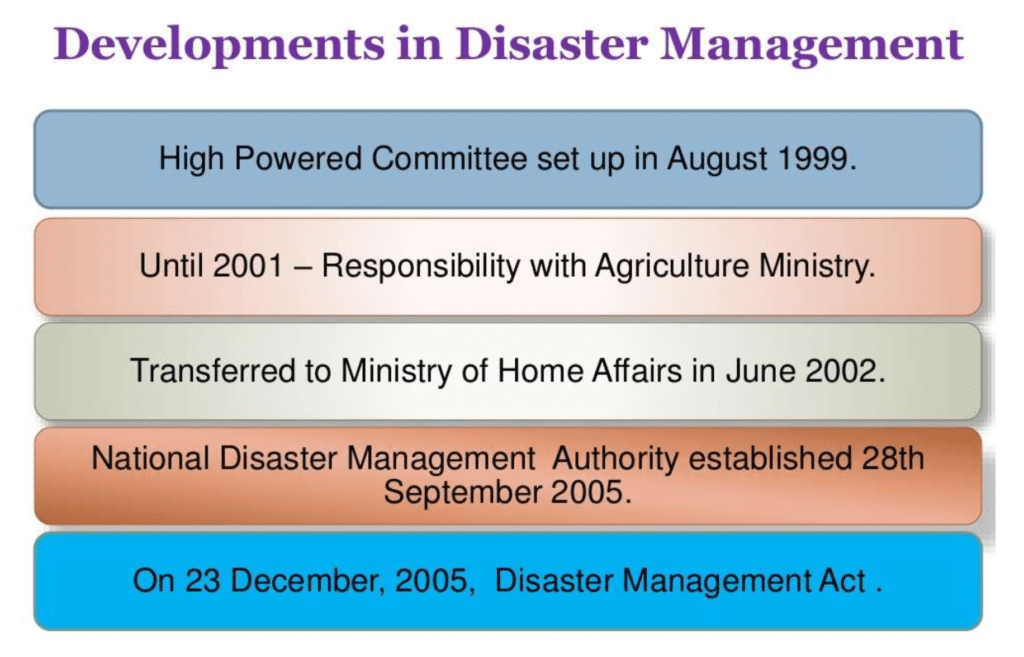Understanding India’s Disaster Management Policies

India faces numerous natural calamities each year, impacting agriculture and livelihoods. The government has established a framework for disaster management to address these challenges. This article explores the National Policy on Disaster Management (NPDM), the role of state and central governments, and the financial assistance provided to farmers affected by natural disasters.
The Framework of Disaster Management in India
The National Policy on Disaster Management (NPDM) outlines the responsibilities of various government levels in managing disasters. According to the NPDM, state governments hold the primary responsibility for disaster management. They are tasked with implementing relief measures during natural calamities using funds from the State Disaster Response Fund (SDRF). This fund is allocated based on guidelines approved by the Government of India.
In addition to state efforts, the central government plays a supportive role. It provides logistical and financial assistance to state governments. In cases of severe disasters, the National Disaster Response Fund (NDRF) comes into play. The NDRF provides additional financial support after an assessment by an Inter-Ministerial Central Team (IMCT). It is important to note that the financial assistance from both SDRF and NDRF is intended for relief efforts, not for compensation.
The government does not maintain centralized data on crop losses due to natural disasters. However, states report crop loss details, particularly from hydro-meteorological disasters. This information is crucial for understanding the impact of disasters on agriculture and for planning future interventions.
Financial Assistance for Affected Farmers
To support farmers facing crop losses due to natural calamities, the Indian government has introduced several insurance schemes. The Pradhan Mantri Fasal Bima Yojana (PMFBY) and the Restructured Weather Based Crop Insurance Scheme (RWBCIS) are two key initiatives. These schemes aim to provide financial support to farmers affected by adverse weather conditions and natural disasters.
The PMFBY and RWBCIS offer comprehensive risk insurance from pre-sowing to post-harvest losses. The schemes operate on an area approach, meaning that claims are calculated based on the yield data submitted by state governments. This approach ensures that farmers receive timely assistance. Claims must be processed within 21 days, regardless of whether insurance companies have completed their verification processes. If there are delays, penalties are automatically calculated and imposed.
Since their inception in 2016, these schemes have paid out approximately ₹172,138 crores to around 19.59 crore farmer applications. This substantial financial support underscores the government’s commitment to safeguarding farmers’ interests during challenging times.
Impact of Hydro-Meteorological Disasters on Agriculture
Hydro-meteorological disasters, such as floods and droughts, have a significant impact on agriculture in India. The data collected from various states reveals the extent of crop damage caused by these disasters. For the financial year 2024-25, the provisional data indicates that a total of 14.24 lakh hectares of cropped area has been affected across several states.
States like Andhra Pradesh, Assam, and Karnataka have reported varying degrees of crop loss. For instance, Andhra Pradesh reported 0.11 lakh hectares affected, while Assam faced losses on 1.38 lakh hectares. These figures highlight the vulnerability of agriculture to natural disasters and the need for effective disaster management strategies.
The government continues to monitor these situations closely. By collecting data on crop losses and providing timely assistance, it aims to mitigate the adverse effects of disasters on farmers and ensure food security for the nation.
Observer Voice is the one stop site for National, International news, Sports, Editor’s Choice, Art/culture contents, Quotes and much more. We also cover historical contents. Historical contents includes World History, Indian History, and what happened today. The website also covers Entertainment across the India and World.

